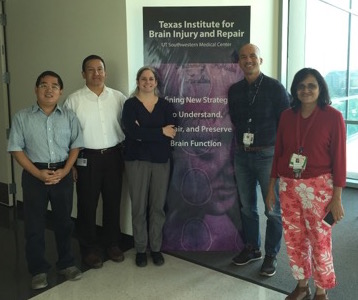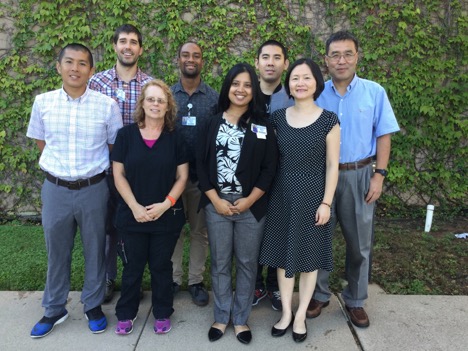2015 TIBIR Pilot Grant Recipients
A longitudinal study of electrophysiological and histological correlates of repeated mild traumatic brain injury
PI: Levi Good, Ph.D.
Department: Neurology and Neurotherapeutics
Challenge
An estimated 1.7 million traumatic brain injuries (TBI) occur annually in the United States with about 75 percent of these categorized as mild TBI (mTBI) or concussion. mTBI has been implicated in nearly 75 percent of brain injuries reported in U.S. military operations from 2000-2012, and sports related concussions have increased interest in repetitive mTBI research over the past few years because of a high correlation with repeated concussions linked to the development of chronic traumatic encephalopathy (CTE) which can only be diagnosed postmortem. While initial damage in mTBI may be minimal (undetected by conventional MRI), the chronic neurodegenerative effects can persist for weeks or months post-injury and lead to significant cognitive, sensory, and psychiatric dysfunctions. TBI has been associated with a variety of electrophysiologic changes, due to missing or interrupted brain circuits and alterations to surviving structures. The electroencephalogram (EEG), evoked potentials (EPs), and event-related potentials (ERPs) are noninvasive procedures that can contribute to the diagnosis, prognosis, and rehabilitative assessments of TBI patients. While these methods are commonly used to assess patients with TBI, there exists much controversy with quantitative methods in mild traumatic brain injury and new more sophisticated analytical techniques are necessary to improve the reliability and specificity of EEG analysis in mTBI.
Approach
We will use a rodent model of repeated mild traumatic brain injury to assess the utility of nonlinear time series analysis of EEG data, ERP signal content and then correlate with histological markers for neuronal and glial cell changes over time.
Overall Goals
The goal of this project is to incorporate advanced electrophysiological methods of EEG and ERP signal analysis coupled with a histological analysis of cellular injury in a longitudinal study in a rodent model to link the degree of brain damage with quantifiable electrophysiological measures with nonlinear dynamics. We expect that, by combining information rich signal analysis and morphological injury assessment, the uncertainties related to circuit physiological analysis will be minimized.
Significance
This study could provide the foundation for using advanced signal processing techniques of EEG and ERP data as potential biomarkers for assessing the extent of brain trauma by correlating with histological markers which may contribute to the diagnosis, prognosis and rehabilitative assessment of TBI patients.
Transcranial direct cortical stimulation for traumatic brain injury
PI: John Hart, M.D.
Department: Neurology & Neurotherapeutics
Challenge
One of the leading causes of disability in Traumatic Brain Injury (TBI) is cognitive dysfunction. Currently there are few pharmaceutical or nonpharmaceutical treatment options available. The pharmaceutical options are primarily stimulant-like medications or dopamine agonists that target midline dopaminergic cognitive systems and general cognitive dysfunction. An emerging line of treatment for cognitive dysfunction is electrotherapy (e.g., rTMS, tDCS, tACS.) Our team has extensive experience with repetitive Transcranial Magnetic Stimulation (rTMS)/transcranial Direct Cortical Stimulation (tDCS) as treatments for neuropsychiatric disorders and has recently piloted the technique of High Definition (HD) tDCS, which uses an electrode cap with smaller electrodes that allows for more targeted electrical stimulation from one electrode to be transmitted to multiple other electrodes, thus focusing electrical stimulation on specific brain regions. There are several proposed mechanisms, with one being that tDCS leads to modulating the neuronal resting membrane potentials via sodium and calcium dependent channels (Liebtanz et al., 2002). The technique is also proposed to increase the neuronal firing rate leading to changes in long-term potentiation and depression (de Aguiar et al., 2015). These purportedly lead to long-term enhancement of signal transmission between neurons that can strengthen neuronal connections. While the stimulation is site-specific, it is proposed that the effects extend via the connections from the increased neuronal firing at the site to strengthen weak connections within a neural circuit.
Approach
After identifying TBI patients with word retrieval deficits using standard neuropsychological measures, we plan to recruit 30 subjects to address the following aims: Aim 1. Assess baseline electrophysiological (ERP and time-frequency) markers of memory retrieval. We have previously studied and characterized some of the neurophysiological properties of the pre-SMAcaudate-thalamic-cortical circuit that supports the semantic processes essential to retrieval (Hart et al., 2013). Aim 2. Administer 10 sessions of either 1 milliamp high definition tDCS or sham to the pre-SMA region. Aim 3. Repeat baseline neuropsychological and EEG measures of memory retrieval.
Overall goals
By using HD tDCS we can entrain this retrieval circuit by targeting the pre-SMA in order to improve memory retrieval in impaired TBI patients, using behavioral and electrophysiological markers to assess outcomes.
Significance
1. At the conclusion of this 12-month study, the development of HD tDCS as a noninvasive, nonpharmacological treatment for cognitive dysfunction in TBI will provide a novel, targeted therapeutic intervention with few side effects or drug interactions, and could potentially be added to other medical treatment regimens. 2. We have targeted a specific and significant cognitive deficit in TBI patients that is associated with a defined neural circuit and objective EEG markers to assess outcomes. The study will further inform the model of the neural circuit and provide further validation of EEG markers of impairments and recovery in TBI patients. 3. If successful, this new treatment approach (electrical stimulation) can be readily applied to other brain regions for treatment of various cognitive impairments in patients with TBI.
Maintenance of cerebral perfusion pressure in moderate to severe traumatic brain injury attenuates central nervous system inflammation after traumatic brain injury

Department: Neurology & Neurotherapeutics, Pediatrics
Challenge
TBI causes disturbances in cerebral blood flow thereby compromising cerebral perfusion pressure. In the last decade there has been significant progress in methodology to assess cerebral autoregulation. Disturbances in cerebral perfusion can cause shear stress to the venules which can then lead to egress of white blood cells into the brain causing inflammation and auto reactivity to the brain antigens. In this study we are trying to understand the disturbances in cerebral autoregulation in TBI in pediatric patients and how these disturbances can lead to neuroinflammation and auto reactivity.
Approach
The PIs, Lakshmi Raman, M.D., and Darryl Miles, M.D., are collaborating with Fenghua Tian, Ph.D., at UT Arlington to study the disturbances in cerebral autoregulation at the microcirculation levels using an advanced algorithm of wavelet transform coherence (WTC) for analysis of the cross-correlation of mean arterial blood pressure and cerebral blood flow as well as the cross-correlation of mean arterial blood pressure and differential hemoglobin concentration of oxygenated and deoxygenated hemoglobin.
The PI’s will also be collaborating with Ann Stowe, Ph.D., to study the egress of white blood cells into the brain using flow cytometry methods. This will help to analyze the various lymphocyte populations in the blood and CSF. In addition, these cells will be tested later for auto reactivity to different brain myelin and neuronal antigens.
Overall Goals
To understand cerebral autoregulation disturbances at the micro and macro circulation level and how these disturbances influence the neuro-inflammation in pediatric TBI.
Significance
This study could provide the basis for management of intracranial hypertension and optimizing cerebral perfusion pressure at the bedside in pediatric TBI.
The role of a novel nuclease PAAN1 in traumatic brain injury

Department: Pathology; Neurology & Neurotherapeutics
Challenge
Neuronal cell death significantly contributes to the long-term disability and even death in patients with traumatic brain injury. So far no effective therapy is available for traumatic brain injury patients. DNA damage and oxidative stress-induced poly(ADP-ribose) polymerase-1 (PARP-1) over-activation plays a critical role in neuronal cell death following traumatic brain injury. Systemic inhibition of PARP-1 attenuates neuronal cell loss, reduces the lesion volume, and significantly improves the motor function recovery in traumatic brain injury. Genetic evidence also showed that PARP-1 knockout mice are robustly resistant to acute brain injury. However, the molecular mechanisms underlying PARP-1-dependent cell death (parthanatos) in traumatic brain injury remains largely unknown.
Approach
To understand the molecular mechanisms of PARP-1-depenent neuronal cell death following brain injury, we recently performed two sequential unbiased high throughput screens, identified a key cell death effector PAAN, and have characterized this protein as a novel nuclease. In this project, we will study the direct functions of PAAN in neuronal cell death in the controlled cortical impact (CCI) model for traumatic brain injury using PAAN knockout mice. Further we will determine the role of PAAN nuclease activity in traumatic brain injury by intracerebroventricular (ICV) injection of a nuclease activity deficient PAAN into PAAN knockout mice. This study may provide the direct evidence that PAAN is the long-sought nuclease required for chromatinolysis and neuronal death in acute brain injury.
Overall goals
To understand the molecular mechanisms of neuronal cell death following traumatic brain injury, to identify novel therapeutic targets, and develop new therapeutic strategies to prevent or treat neurologic diseases.
Significance
This study may promisingly discover a new druggable target for the treatment of traumatic brain injury.
Aerobic exercise as a treatment for traumatic brain injury

PI: Rong Zhang, Ph.D., and Kan Ding, M.D.
Department: Neurology and Neurotherapeutics
Challenge
Traumatic brain injury (TBI) related mental and physical health such as memory and executive dysfunction, depression, anxiety, and fatigue affect survivor’s daily living and impact quality of life (QOL). In addition, TBI exacerbates age-related cognitive decline and is an important risk factor for Alzheimer’s disease. Despite decades of research work, no pharmacological approaches have been demonstrated to be effective for improving brain recovery after TBI. Aerobic exercise has been used as a non-pharmacological approach to prevent and treat depression and improve cognitive function and emotional health in other neurological conditions. However, potential benefits of exercise on brain health have not been sufficiently capitalized in TBI patients.
Approach
Conducting exercise trials with an ultimate goal to improve physical and mental wellbeing in TBI survivors can be challenging because of the presence of both physical and mental barriers which must be overcome to make exercise and adherence to exercise feasible in these patients. The high prevalence of physical inactivity (or deconditioning) may contribute significantly to the diminished quality of life in TBI survivors. Therefore, identification of barriers and development of effective and personalized exercise training programs are likely to be the key to promote physical activity in TBI patients. Moreover, a paradigm shift to focus on patient-reported outcome (PRO) measures is needed for clinical studies in TBI – a transformative change in clinical research for prevention and treatment of chronic diseases.
Overall Goals
The overall goal of this pilot study is to explore the feasibility of implementation of a novel personalized aerobic exercise training program to improve patient-reported mental and physical health and quality of life in TBI patients. Furthermore, state-of-the-art neuroimaging techniques will be used to examine neuroplastic effects of aerobic exercise on brain structure and function.
Significance
This study may provide a better understanding of the feasibility of conducting aerobic exercise training in TBI patients and whether exercise improves health-related quality of life after brain injury. In addition, preliminary data of effects of aerobic exercise on brain structure and function will be obtained in this population.

